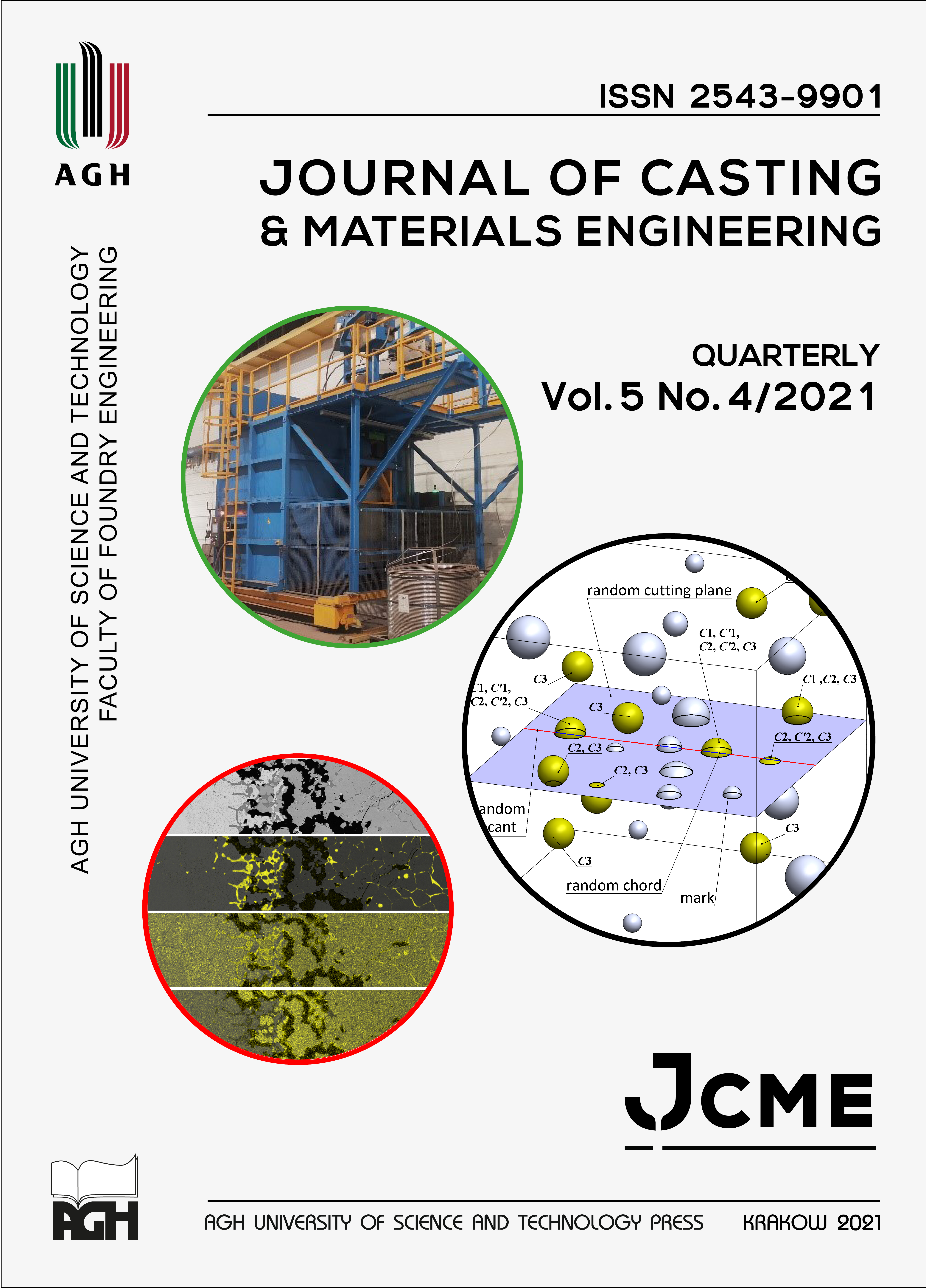Set-up of a Generalized Dataset for Crack-Closure-Mechanisms of Cast Steel
DOI:
https://doi.org/10.7494/jcme.2021.5.4.84Abstract
In components, crack propagation is subjected to crack-closure-mechanisms which affect the build-up of the relevant threshold stress intensity factor range during cyclic loading. As structural parts are exposed to service loads incorporating a variety of load ratios, a significant change of the long-crack threshold value occurs, leading to a severe stress ratio dependency of crack-closure-mechanisms. Thus, an extensive number of crack propagation experiments is required to gain statistically proven fracture mechanical parameters describing the build-up of closure effects as crack growth resistance curves.
The article presents a generalized dataset to assess the formation of crack-closure-mechanisms of cast steel G21Mn5+N. Numerous crack propagation experiments utilizing single edge notched bending (SENB) sample geometries are conducted, incorporating alternate to tumescent stress ratios. The statistically derived, generalized crack growth resistance curve features the impact of closure effects on the crack propagation rate in a uniform manner. To extend the dataset to arbitrary load ratios, the long-crack threshold approach according to Newman is invoked. The generalized dataset for the cast steel G21Mn5+N is validated by analytical fracture mechanical calculations for the utilized SENB-sample geometries. Incorporating a modified NASGRO equation, a sound correlation of analytical and experimental crack propagation rates is observed. Moreover, the derived master crack propagation resistance curve is implemented as a user-defined script into a numerical crack growth calculation tool and supports a local, node--based numerical crack propagation study as demonstrated for a representative SENB-sample. Concluding, the derived dataset facilitates the calculation of fatigue life of crack-affected cast steel components subjected to arbitrary stress ratios.
Downloads
References
Campbell J. (2011). Complete Casting Handbook. Oxford, UK: Elsevier Butterworth-Heinemann.
Collini L., Pirondi A., Bianchi R., Cova M. & Milella P.P. (2011). Influence of casting defects on fatigue crack initiation and fatigue limit of ductile cast iron. Procedia Engineering, 10, 2898–2903. Doi: https://doi.org/10.1016/j.proeng.2011.04.481.
Maierhofer J., Pippan R. & Gänser H.-P. (2014). Modified NASGRO equation for physically short cracks. International Journal of Fatigue, 59, 200–207. Doi: https:doi.org/10.1016/j.ijfatigue.2013.08.019.
Schuscha M., Leitner M., Stoschka M. & Meneghetti G. (2020). Local strain energy density approach to assess the fatigue strength of sharp and blunt V-notches in cast steel. International Journal of Fatigue, 132, 105334. Doi: https://doi.org/10.1016/j.ijfatigue.2019.105334.
DeLuca F. (2020). Experimental and theoretical analysis of crack propagation thresholds of metal materials. Universita Degli Studi Di Padova [Master thesis].
Tabernig B. & Pippan R. (2002). Determination of the length dependence of the threshold for fatigue crack propagation. Engineering Fracture Mechanics, 69(8), 899–907. Doi: https://doi.org/10.1016/S0013-7944(01)00129-1.
Oberreiter M., Aigner R., Pomberger S., Leitner M. & Stoschka M. (2021). Impact of microstructural properties on the crack threshold of aluminium castings. Engineering Fractue Mechanics, 241, 107431. Doi: https://doi.org/10.1016/j.engfracmech.2020.107431.
Kolitsch S., Gänser H.-P., Maierhofer J. & Pippan R. (2016). Fatigue crack growth threshold as a design criterion – statistical scatter and load ratio in the Kitagawa-Takahashi diagram. IOP Conference Series: Materials Science and Engineering, 119, 12015. Doi: https://doi.org/10.1088/1757-899X/119/1/012015.
Berger C. (2009). Fracture mechanics proof of strength for engineering components. Frankfurt am Main: VDMA.
Murakami Y. (2001). Stress intensity factors handbook. Kyoto: The Society of Materials Science, Japan.
Newman J.C. (1984). A crack opening stress equation for fatigue crack growth. International Journal of Fracture, 24(4), R131–R135. Doi: https:doi.org/10.1007/BF00020751.
Mettu S., Shivakumar V., Beek J., Yeh F., Williams L., Forman R., McMahon J. & Newman I. (1999). NASGRO 3.0: A software for analyzing aging aircraft. The Second Joint NASA/FAA/DoD Conference on Aging Aircraft: August 31 – September 3, 1998. Williamsburg, Virginia, 792–801. Hampton, Virginia: NASA Langley Research Center.
Downloads
Published
Issue
Section
License
Copyright (c) 2021 Michael Horvath, Matthias Oberreiter, Michael Stoschka, Martin Leitner

This work is licensed under a Creative Commons Attribution 4.0 International License.
How to Cite
Accepted 2021-10-26
Published 2021-11-24


